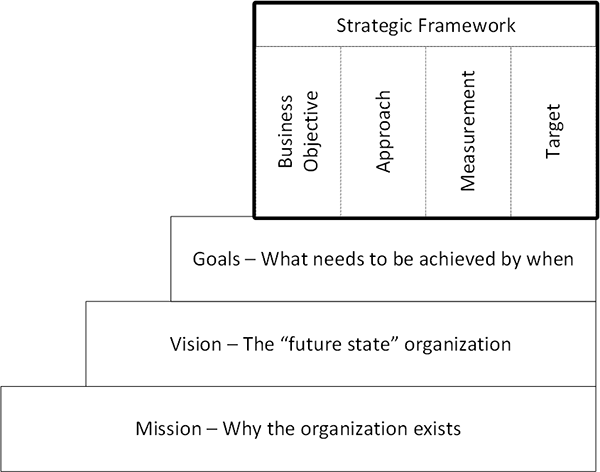Date Published January 30, 2018 - Last Updated December 13, 2018
Have you been part of a project whose outcomes fell short of promises? Have you had a good idea that just didn’t get any traction or support with your management? Were the goals and objectives of that good idea or project clearly linked to the objectives of your stakeholders? Did you develop a strategic framework?
What Is the Strategic Framework?
A strategic framework is a structured method used to define how a project or initiative supports the key objectives of stakeholders. There are four components to a strategic framework:
-
Business objective. What will the project or initiative achieve?
-
Approach. How will that achievement be realized?
-
Measurement. How will achievement be measured and reported?
-
Target. What is the forecasted improvement that will define success?
To ensure success, the strategic framework must be based on the organization’s mission, vision, and goals (MVG). The mission statement explains the purpose of the organization, why the organization exists. The vision statement describes what the organization aspires to be; it describes the “future state” organization. Goals articulate what needs to be achieved by when, but do not describe how those goals will be achieved. That’s where a strategic framework comes in. The strategic framework addresses how a project or initiative will help the organization achieve its MVG.

The strategic framework must be based on the organization’s mission, vision, and goals.

However, this alone will not ensure the success of our project or initiative. We need the support and buy-in from key stakeholders. Who are the key stakeholders of a strategic framework?
-
Teammates. The immediate group of people with whom you work.
-
Organization. The business or company for whom you work.
-
Customers. The people that buy or use the products or services produced by your organization.
For each stakeholder group, the strategic framework should answer the WIIFM (“What’s In It For Me?”). A strategic framework should briefly discuss how each stakeholder group—teammates, organization, and customers—will benefit from the completion of the initiative.
To be clear, the strategic framework is not a repeat of a project plan or a business case. A project plan is a detailed document that discusses the resource requirements and timeframes for accomplishing a series of tasks over a defined period of time. A business case is a formalized justification for a significant expenditure, which includes a discussion of risks, alternatives, and methodologies. The strategic framework complements both of these documents, and while it requires a little bit more effort to develop, your project or initiative will benefit.
Benefits of Developing a Strategic Framework
In addition to answering your stakeholders’ WIIFMs and relating a project to an organization’s MVG, there are other benefits of developing a strategic framework.
A natural outcome from the strategic framework is the beginnings of a comprehensive communication plan. A communication plan describes what messages are going to be delivered to what audiences via what media or format at what time or interval. Since you’ve already answered the WIIFM as part of developing the strategic framework, you’ve got a great start on the communication plan.
A strategic framework enables the survivability of your project through changes within management. Let’s face it. An organization’s management does sometimes change, and new managers usually come into their new roles with new ideas and thinking. Does this mean that your good idea or project is subject to getting postponed or cancelled? Frankly, yes! Your project will very likely be scrutinized by those new managers. However, because a well-defined strategic framework relates your project’s outcomes to achieving the organization’s MVG, the chances of having your project cancelled are minimized. (Also, what a great way to make a good first impression with that new manager!)
Lastly, developing a strategic framework enables business-like conversations with senior leaders about how your initiative helps the organization achieve its MVG. No one will ever kick you out of their office for having a balanced and well-thought discussion on how to help the organization be successful.
Build Your Strategic Framework
Ready to build a strategic framework for your project? First, review the organization’s MVG. Identify how your great idea or project will help the organization achieve its goals.
Develop a high-level approach, detailed enough to demonstrate that you’ve thought through the sequence of activities and what resources are required.
Next, establish how progress will be measured and reported. Where are you now? What measures reflect where you are now? Identify measures that reflect and quantify progress toward achieving the organization’s MVG.
Now that you know where you are now and how you’re going to measure progress, establish a target. How much progress within what timeframe would be considered a success? Establishing measures and targets are critical steps; choose the wrong measures or set an unrealistic target and candidly, your project is doomed. Identify relevant, meaningful measures that will quantify the progress toward meeting your target, which in turn, helps your organization meet a goal.
What are the key messages for each stakeholder group—teammates, organization, and customers? What questions will each stakeholder group have about your initiative? What do you want each stakeholder group to know about your idea or initiative?
Now document what you’ve developed, and Voila! You’ve defined a strategic framework!
Get your service management content in person at Service Management World!
Join us!
Doug Tedder is a strategic, innovative, and solutions-driven IT service management professional with more than 20 years of progressive experience across a variety of industries. He’s a resourceful and hands-on leader with track record of success implementing ITSM and IT governance processes. Doug is a certified ITIL Expert and ISO/IEC 20000 Consultant Manager and holds many other industry certifications. In addition, Doug is an accredited ITIL Foundation trainer and HDI Support Center Analyst and Support Center Manager instructor. Follow Doug on Twitter and connect with him on LinkedIn.